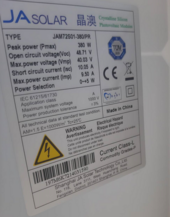crossy
Solar Addict
I have an array of 3S2P x 380W panels, Voc 48.71V Isc 10.05A
So worst case should be Voc 146.13V and 20.1A.
This array is being switched by an SSR - DD 220VDC x 100A this "should" have no issues with the energy involved. SSR is mounted on the recommended "100A" heatsink using heat-transfer gloop and securely bolted down.
BUT
I've popped two SSRs, both have failed short-circuit.
The other side is feeding the input to a PowMr 60A MPPT which tends to over-charge the 48V pack hence the SSR to kill the panels.


Any bright ideas? What am I doing to kill these SSRs and what can I do to prevent it?
So worst case should be Voc 146.13V and 20.1A.
This array is being switched by an SSR - DD 220VDC x 100A this "should" have no issues with the energy involved. SSR is mounted on the recommended "100A" heatsink using heat-transfer gloop and securely bolted down.
BUT
I've popped two SSRs, both have failed short-circuit.
The other side is feeding the input to a PowMr 60A MPPT which tends to over-charge the 48V pack hence the SSR to kill the panels.


Any bright ideas? What am I doing to kill these SSRs and what can I do to prevent it?
Last edited:


